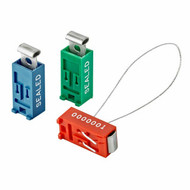Maintain a Robust Program to Verify and Inspect Seals
Posted by Steve Diebold
Security experts, governments, private agencies and shipping organizations all agree that a security seal should be used in conjunction with a well-managed program for handling and inspecting the seals. Without that type of program, a stand-alone seal offers the user limited protection.
Reports and recommendations for seal verification and inspection are published in several countries, but one particularly valuable and independent guide comes from the US Dept of Defense (DOD) Lock Program. This public guide was published several years ago and some of the cited references, groups, and manufacturers have changed. But the information and recommendations it provides are still valid and useful.
VERIFICATION
Verification of seals starts with choosing a reliable source (like AC&M) who maintain high standards of inspection and inventory control according to ISO and other global agencies.
AC&M has superior experience, reputation, and reliability going back over a century. We comply with ISO-9001:2015 standards as well as ISO-17712 Annex A for production and control of security seals. AC&M is also a founding member of ISMA (International Seal Manufacturers Association). In addition to making the highest quality seals in today’s market, assisting our customers in effective and secure seal use is also a top priority. We provide a summary guide to best practices in seal selection and use. Our web site contains a comprehensive guide to seals overall, and we provide basic guides for seal monitoring and control to our customers at no cost.
Verification of seals also requires knowledgeable users, with information needed to select the right seal type and verify that the seals they ordered match the seals delivered.
INSPECTION
For nearly two decades US Customs and Border Protection and the World Customs Organization have recommended (specifically for container seals) to follow the VVTT method of seal inspection.
V – View seal & container locking mechanisms
V – Verify seal number for accuracy
T – Tug on seal to make sure it is affixed properly
T – Twist & Turn seal to make sure it does not unscrew
This simple method can apply to any seal. However, the twisting step applies only to seals with ring locks such as bolt seals. Also, within the comprehensive DOD guide is a recommendation to inspect for these things: (list quoted from DOD)
- Missing seal
- Open seal
- Seal number discrepancy
- Improperly installed seal
- Unauthorized seal
- Uncontrolled seal
- Easy opening of the seal under hand pressure
- Presence of free play or rotation
- Frayed appearance
- Evidence of glue or application of heat
- Blushing or color change of plastic
- Scratches or nicks adjacent to the locking mechanism
- Deformation of the locking mechanism
- Apparent rebuilding or substitution of component parts
- Suspect printed or embossed letters or numbers
The most critical inspection points in the life of a seal are at the installation and removal. Some highly sensitive seal programs go to the lengths of photographing each seal at the beginning and end of use, then closely scrutinizing the photos to assure the seals match and are in suitable condition after use.
RELIABILITY
All of these recommendations rely on the people involved are informed, reliable and trusted. After the time and effort goes into getting the right seal and establishing a strong program of tracking, inspection and documentation, it does not work without people trusted to properly handle and inspect the seals. It is important that education and training of those who handle seals includes information specific to the type seals in use.
Having a reliable verification/inspection program is not limited to only seals that are rated as High Security (H) under ISDO-17712. While these are the most monitored types of seals there are countless seal applications that are equally important using plastic band seals, padlock seals, wire seals and other indicative type seals. The (H) category is a strength-based classification. The level of security and tamper evidence is not determined by strength. Most seals in all strength categories provide exceptional security when applied with a will managed inspection regimen.
While many of the standards mentioned here are focused on seals for shipping there are many highly sensitive uses for tamper evident seals in other sectors. Medical, pharmaceutical, law enforcement, energy, banking, chemical, hazmat, food processing, military, telecom, and so many sectors of business and government need reliable seal monitoring for tamper detection and protecting all aspects of our daily lives.
RELY ON AC&M
As a leading manufacturer of seals since 1910 American Casting & Mfg. Corporation has the experience and resources to assist seal users in getting the best seal for their purposes and creating an effective program to verify and inspect them.
We invite you to ask any questions or request advice, product information, samples or other information on seals and their use. Call or chat online during EDT business hours or contact us anytime through our web site.

